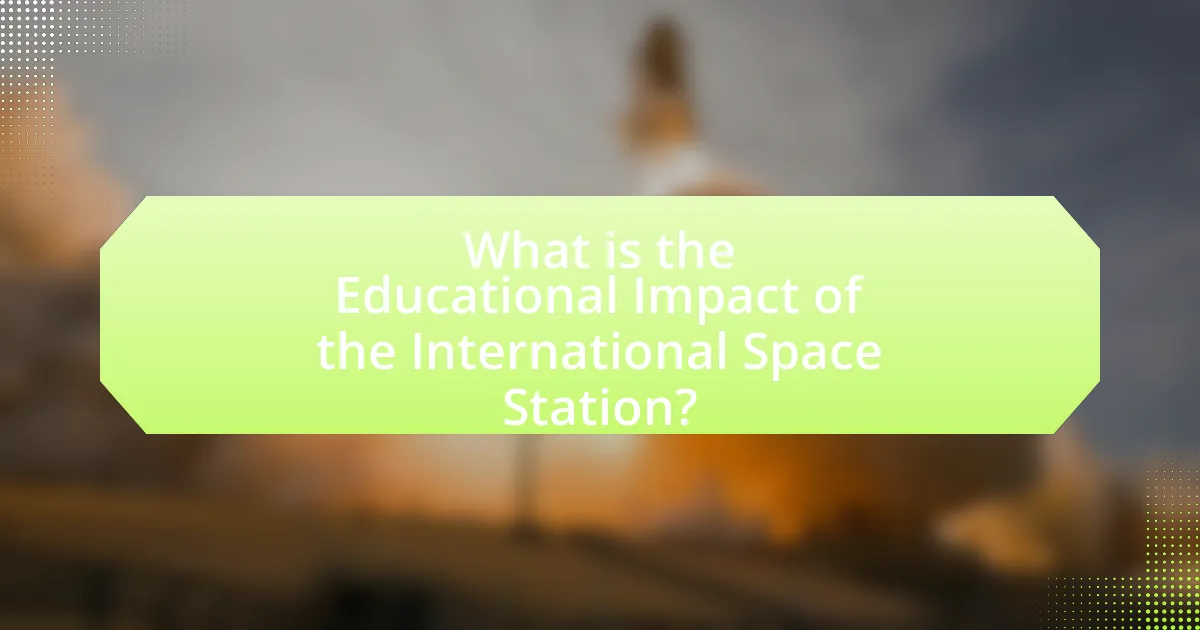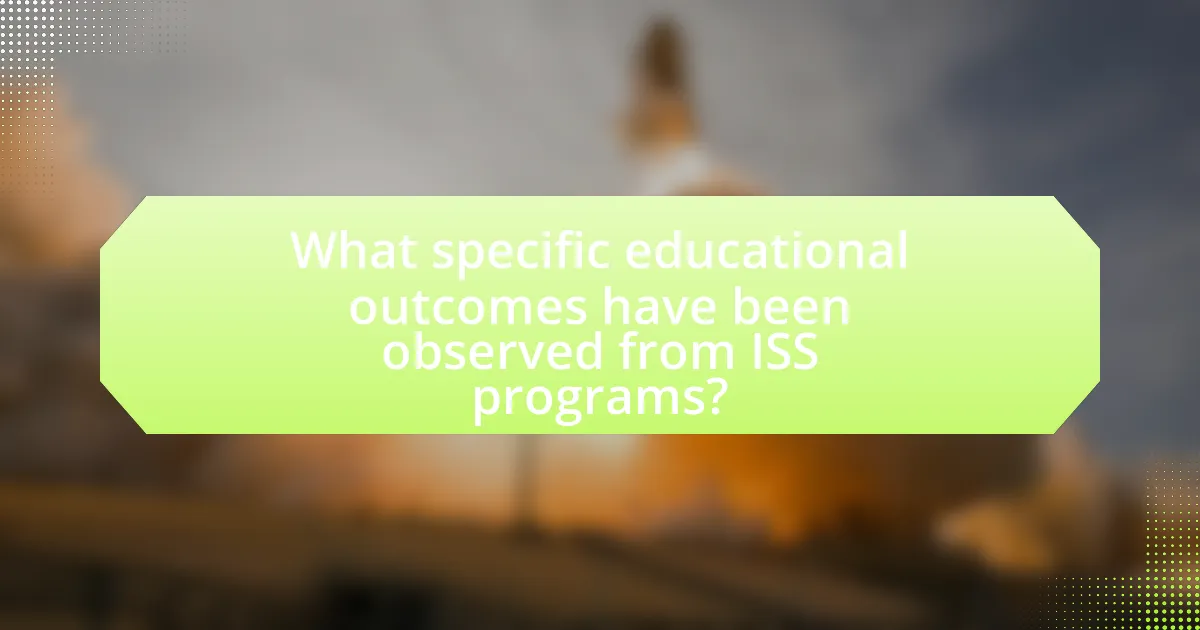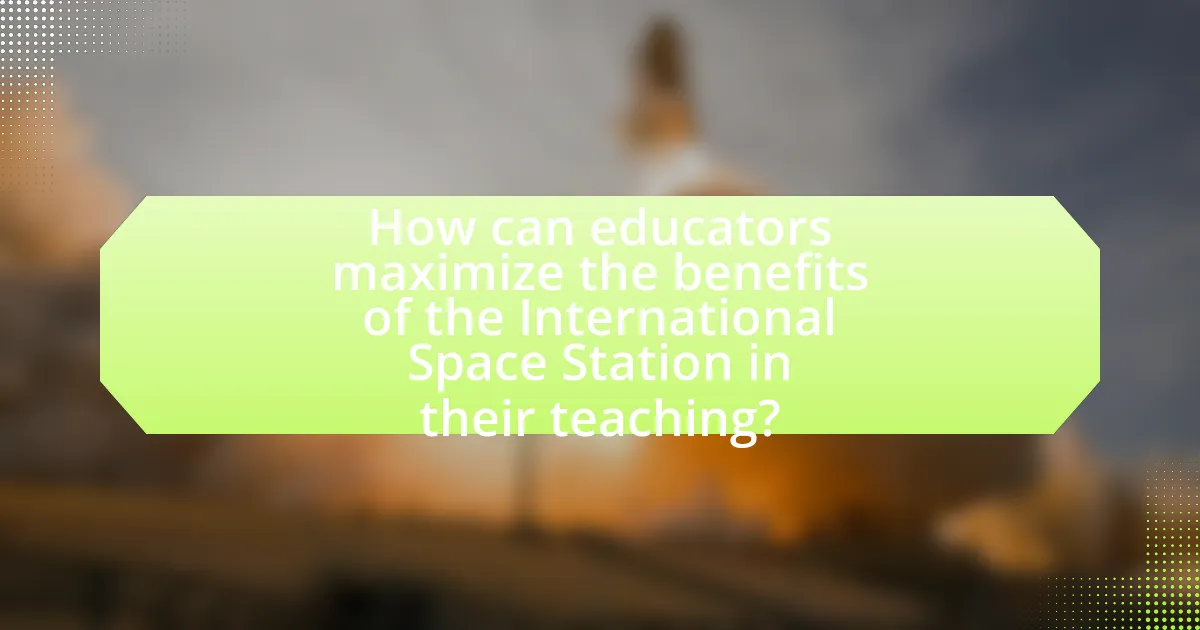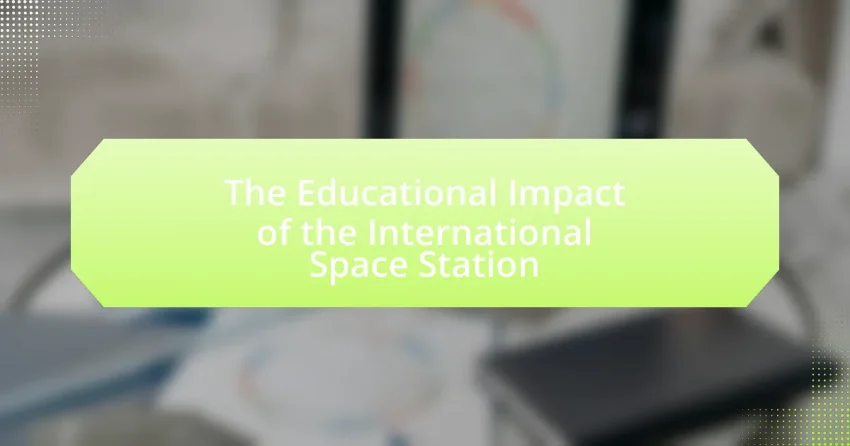The International Space Station (ISS) serves as a pivotal platform for enhancing STEM (Science, Technology, Engineering, and Mathematics) education through hands-on learning experiences and real-time scientific research. It offers various educational programs, such as the Student Spaceflight Experiments Program and NASA’s Educational Activities, which allow students to design and conduct experiments in microgravity, fostering engagement and interest in scientific inquiry. The ISS also provides educators with valuable resources, including live video feeds and interactive sessions with astronauts, which enhance curriculum development and student understanding of space science. Furthermore, international collaborations involving the ISS promote global educational initiatives, inspiring future scientists and engineers while addressing challenges educators face in integrating space-related content into their teaching.

What is the Educational Impact of the International Space Station?
The educational impact of the International Space Station (ISS) is significant, as it serves as a unique platform for scientific research and STEM (Science, Technology, Engineering, and Mathematics) education. The ISS facilitates hands-on learning experiences for students through programs like the Student Spaceflight Experiments Program, which allows students to design and conduct experiments in microgravity. Additionally, the ISS provides real-time data and resources for educators, enhancing curriculum development and student engagement in space science. Research conducted aboard the ISS has led to advancements in various fields, including biology and materials science, which are integrated into educational content, demonstrating the practical applications of scientific principles.
How does the International Space Station contribute to education?
The International Space Station (ISS) contributes to education by providing a platform for hands-on learning experiences in science, technology, engineering, and mathematics (STEM). Through programs like the NASA Educational Activities, students engage in experiments that are conducted in microgravity, fostering interest in scientific inquiry and research. For instance, the ISS has hosted over 200 educational experiments designed by students, allowing them to apply theoretical knowledge in a practical setting. Additionally, the ISS serves as a resource for educators, offering access to live video feeds, educational materials, and opportunities for students to interact with astronauts, thereby enhancing their understanding of space exploration and its relevance to everyday life.
What educational programs are associated with the International Space Station?
The International Space Station (ISS) is associated with several educational programs, including the NASA’s “Education Launch” initiative, which engages students in STEM activities related to space exploration. Another program is “The ISS National Lab,” which provides educational opportunities for students to conduct experiments in microgravity. Additionally, “Space Station Explorers” offers hands-on learning experiences through partnerships with various educational organizations. These programs aim to inspire the next generation of scientists and engineers by providing real-world applications of science and technology in space.
How does the ISS facilitate hands-on learning experiences for students?
The International Space Station (ISS) facilitates hands-on learning experiences for students through its educational programs and real-time experiments conducted in microgravity. Programs like the Student Spaceflight Experiments Program (SSEP) allow students to design and propose experiments that are launched to the ISS, where they can observe the results firsthand. Additionally, the ISS provides live video feeds and interactive sessions with astronauts, enabling students to engage directly with space science and technology. These initiatives have been shown to enhance student interest in STEM fields, as evidenced by increased participation in science and engineering courses following involvement in ISS-related projects.
Why is the International Space Station significant for STEM education?
The International Space Station (ISS) is significant for STEM education because it serves as a unique platform for hands-on learning and research in science, technology, engineering, and mathematics. The ISS facilitates experiments that cannot be conducted on Earth, such as studies on microgravity’s effects on biological systems, which enhances students’ understanding of scientific principles. For instance, over 2,000 experiments have been conducted aboard the ISS, providing real-world applications of STEM concepts and inspiring students to pursue careers in these fields. Additionally, the ISS offers educational programs and resources, such as live video feeds and interactive lessons, which engage students and foster interest in STEM disciplines.
What role does the ISS play in inspiring future scientists and engineers?
The International Space Station (ISS) plays a crucial role in inspiring future scientists and engineers by providing a unique platform for hands-on learning and research in a microgravity environment. The ISS serves as a living laboratory where students and educators can engage with real-world scientific experiments, fostering interest in STEM (Science, Technology, Engineering, and Mathematics) fields. Programs like the ISS National Lab and initiatives such as “Student Spaceflight Experiments Program” allow students to design and conduct experiments that are launched to the ISS, directly involving them in the scientific process. This experiential learning approach has been shown to increase student engagement and interest in pursuing careers in science and engineering, as evidenced by surveys indicating that students involved in ISS-related projects report higher aspirations to enter STEM fields.
How does the ISS enhance the understanding of scientific concepts in classrooms?
The International Space Station (ISS) enhances the understanding of scientific concepts in classrooms by providing real-time data and experiments that illustrate principles of physics, biology, and Earth sciences. Through programs like the NASA Educational Activities, students can engage with live experiments conducted in microgravity, which helps them grasp complex concepts such as fluid dynamics and the effects of gravity on biological processes. For instance, experiments on the ISS have shown how plants grow differently in space, allowing students to observe and analyze the impact of microgravity on plant biology, thus reinforcing their understanding of scientific theories.
What are the global educational collaborations involving the International Space Station?
The global educational collaborations involving the International Space Station (ISS) include initiatives such as the Student Spaceflight Experiments Program (SSEP), which allows students to design and conduct experiments in microgravity. Additionally, the ISS National Lab collaborates with educational institutions worldwide to promote STEM education through hands-on learning experiences. Programs like the European Space Agency’s (ESA) “Fly Your Satellite!” enable students to develop and test their experiments in space. These collaborations enhance educational opportunities and foster international partnerships in science and technology, demonstrating the ISS’s role as a platform for global educational engagement.
Which countries participate in educational initiatives related to the ISS?
Countries that participate in educational initiatives related to the International Space Station (ISS) include the United States, Canada, Japan, Russia, and member countries of the European Space Agency (ESA). These nations engage in various programs aimed at promoting STEM education, such as the ISS National Lab in the U.S., which supports educational projects and experiments conducted by students and educators. Additionally, ESA’s educational outreach initiatives involve collaboration with schools across its member states, fostering international partnerships in space education.
How do international partnerships enhance educational opportunities through the ISS?
International partnerships enhance educational opportunities through the International Space Station (ISS) by facilitating collaborative research, sharing resources, and providing diverse learning experiences. These partnerships enable students and educators from various countries to engage in joint projects, such as experiments conducted in microgravity, which promote scientific inquiry and innovation. For instance, the ISS National Lab collaborates with educational institutions globally, allowing students to design experiments that are launched to the ISS, thereby fostering hands-on learning and real-world application of scientific concepts. Additionally, international partnerships often lead to the exchange of knowledge and best practices in STEM education, enhancing curriculum development and teacher training across participating nations.
How does the International Space Station engage students and educators?
The International Space Station engages students and educators through interactive educational programs and real-time communication opportunities with astronauts. Programs like the “NASA’s Educational Activities” provide resources, lesson plans, and live video sessions that allow students to ask questions directly to astronauts aboard the ISS. Additionally, initiatives such as the “Student Spaceflight Experiments Program” enable students to design and conduct experiments in microgravity, fostering hands-on learning experiences. These efforts are supported by partnerships with educational organizations, ensuring that the ISS serves as a dynamic platform for STEM education and inspiration.
What challenges do educators face when integrating ISS-related content into curricula?
Educators face several challenges when integrating International Space Station (ISS)-related content into curricula, primarily including limited resources, lack of training, and curriculum constraints. Limited resources often refer to insufficient access to materials, technology, and funding necessary to effectively teach ISS-related topics. For instance, many schools may not have the budget to acquire specialized equipment or software that enhances learning experiences related to space science.
Additionally, a lack of training for educators can hinder their ability to confidently teach complex ISS concepts. Many teachers may not have a background in space science or may not have received professional development opportunities focused on this area, leading to gaps in knowledge and teaching effectiveness.
Curriculum constraints also pose a significant challenge, as educators often must adhere to standardized testing requirements and state educational standards that may not prioritize space science. This can result in ISS content being sidelined in favor of subjects that are more heavily tested. According to a study by the National Science Teachers Association, only 25% of teachers reported feeling adequately prepared to teach space science topics, highlighting the need for improved support and resources in this area.

What specific educational outcomes have been observed from ISS programs?
Educational outcomes from International Space Station (ISS) programs include enhanced student engagement in STEM fields, improved critical thinking skills, and increased interest in space exploration careers. Research indicates that students participating in ISS-related activities demonstrate higher levels of motivation and achievement in science and mathematics. For instance, a study by the National Aeronautics and Space Administration (NASA) found that students involved in ISS educational initiatives showed a 20% increase in science test scores compared to their peers. Additionally, programs like the “Student Spaceflight Experiments Program” have led to students developing experiments that foster collaboration and problem-solving skills, further reinforcing the educational benefits of ISS programs.
How do ISS programs impact student engagement and motivation?
ISS programs significantly enhance student engagement and motivation by providing hands-on, real-world applications of science, technology, engineering, and mathematics (STEM) concepts. These programs, such as the Student Spaceflight Experiments Program, allow students to design experiments that are conducted in microgravity, fostering a sense of ownership and relevance in their learning. Research indicates that participation in ISS-related activities leads to increased interest in STEM fields, with 80% of students reporting heightened motivation to pursue science after engaging with ISS programs. This direct connection to space exploration not only captivates students’ imaginations but also encourages critical thinking and problem-solving skills, essential for their academic and professional futures.
What evidence supports the effectiveness of ISS-related educational initiatives?
Evidence supporting the effectiveness of ISS-related educational initiatives includes increased student engagement and improved STEM learning outcomes. Studies have shown that programs like the ISS National Lab’s educational outreach initiatives lead to a 30% increase in student interest in science and technology fields. Additionally, research published in the Journal of Science Education and Technology indicates that students participating in ISS-related projects demonstrate higher problem-solving skills and critical thinking abilities compared to their peers. These findings underscore the positive impact of ISS educational programs on fostering a deeper understanding of science and enhancing educational experiences.
How do students’ attitudes towards science change after participating in ISS programs?
Students’ attitudes towards science generally improve after participating in ISS programs. Research indicates that these programs enhance students’ interest in science, increase their motivation to learn, and foster a positive perception of scientific inquiry. For instance, a study conducted by the National Aeronautics and Space Administration (NASA) found that students who engaged in ISS-related activities reported a 30% increase in their enthusiasm for science subjects. This shift is attributed to hands-on experiences, exposure to real-world applications of science, and the inspirational nature of space exploration.
What skills do students develop through ISS educational activities?
Students develop critical thinking, problem-solving, teamwork, and communication skills through ISS educational activities. These activities often involve hands-on experiments and collaborative projects that require students to analyze data, devise solutions, and work effectively with peers. For instance, participating in experiments designed for microgravity conditions encourages students to think critically about scientific principles and apply them in real-world scenarios. Additionally, the collaborative nature of these projects fosters teamwork and enhances communication skills, as students must articulate their ideas and findings clearly to their peers and educators.
How do ISS programs promote critical thinking and problem-solving skills?
ISS programs promote critical thinking and problem-solving skills by engaging participants in hands-on scientific research and experiments that require analytical reasoning and innovative solutions. These programs often involve real-world challenges that astronauts and students must address, fostering an environment where critical evaluation of data and collaborative problem-solving are essential. For example, experiments conducted on the ISS, such as those related to fluid dynamics in microgravity, necessitate participants to hypothesize, test, and analyze results, thereby enhancing their ability to think critically and solve complex problems.
What collaborative skills are fostered through ISS-related projects?
ISS-related projects foster essential collaborative skills such as teamwork, communication, problem-solving, and cultural awareness. Teamwork is developed as individuals from diverse backgrounds work together towards common goals, often requiring coordination and mutual support. Communication skills are enhanced through the necessity of clear and effective exchanges of ideas and information among team members, which is critical in a multi-disciplinary environment. Problem-solving skills are cultivated as participants face challenges that require innovative solutions, often necessitating collaborative brainstorming and decision-making. Cultural awareness is also promoted, as participants engage with peers from various countries, fostering respect and understanding of different perspectives. These skills are vital for success in both academic and professional settings, as evidenced by studies highlighting the importance of collaboration in STEM education and international cooperation.

How can educators maximize the benefits of the International Space Station in their teaching?
Educators can maximize the benefits of the International Space Station (ISS) in their teaching by integrating real-time data and experiments conducted aboard the ISS into their curriculum. Utilizing resources such as NASA’s educational materials, which include lesson plans and live feeds from the ISS, allows educators to create engaging, hands-on learning experiences that connect students to current scientific research. For instance, the ISS National Lab provides access to experiments in microgravity that can be incorporated into science classes, enhancing students’ understanding of physics and biology. Additionally, partnerships with organizations like the Space Foundation offer professional development for teachers, equipping them with the skills to effectively teach space-related topics. These strategies not only foster student interest in STEM fields but also align with educational standards, making learning relevant and impactful.
What resources are available for educators to incorporate ISS content into lessons?
Educators can access a variety of resources to incorporate International Space Station (ISS) content into lessons, including NASA’s educational materials, online courses, and interactive simulations. NASA provides lesson plans, videos, and activities specifically designed for different grade levels, which align with national education standards. Additionally, organizations like the Space Foundation and the European Space Agency offer resources such as curriculum guides and educational outreach programs. These resources are validated by their use in classrooms across the United States and Europe, demonstrating their effectiveness in enhancing STEM education through real-world applications related to space exploration.
How can teachers access ISS live feeds and educational materials?
Teachers can access ISS live feeds and educational materials through NASA’s official website and the ISS National Lab’s resources. NASA provides a dedicated section for educators that includes live video streams from the ISS, as well as lesson plans and activities aligned with educational standards. The ISS National Lab also offers a variety of educational resources, including interactive modules and real-time data from experiments conducted on the station. These platforms ensure that teachers have the necessary tools to incorporate space science into their curriculum effectively.
What are some best practices for designing ISS-themed lesson plans?
Best practices for designing ISS-themed lesson plans include integrating hands-on activities, aligning with educational standards, and incorporating real-world applications of space science. Hands-on activities, such as experiments simulating microgravity conditions, engage students and enhance learning retention. Aligning lesson plans with national science standards ensures that the content is relevant and meets educational requirements. Additionally, using real-world applications, such as current ISS missions and research, helps students understand the significance of space exploration and its impact on life on Earth. These practices are supported by educational research indicating that experiential learning and relevance improve student engagement and comprehension in science education.
What tips can educators use to engage students with ISS-related projects?
Educators can engage students with ISS-related projects by incorporating hands-on activities that simulate real-life space missions. For example, educators can design experiments that mimic the scientific research conducted on the ISS, such as studying the effects of microgravity on plant growth. This approach not only makes learning interactive but also connects students to actual scientific endeavors, enhancing their understanding of space exploration. Research indicates that experiential learning significantly improves student engagement and retention of information, as seen in studies conducted by the National Science Teachers Association, which highlight the effectiveness of hands-on science education in fostering interest and enthusiasm among students.
How can educators encourage student participation in ISS challenges and competitions?
Educators can encourage student participation in ISS challenges and competitions by integrating these activities into the curriculum and providing hands-on learning experiences. By aligning ISS challenges with educational standards, teachers can demonstrate the relevance of space science to students’ academic goals. Additionally, organizing workshops and informational sessions can raise awareness and spark interest among students. Research shows that active engagement in STEM activities, such as those related to the ISS, significantly boosts student motivation and participation rates. For instance, a study by the National Science Foundation found that students involved in hands-on science projects are 50% more likely to pursue STEM careers.
What strategies can be employed to connect ISS content with local curriculum standards?
To connect International Space Station (ISS) content with local curriculum standards, educators can employ strategies such as aligning ISS educational resources with specific learning objectives outlined in local standards. For instance, teachers can integrate ISS experiments and data into science lessons that focus on topics like gravity, ecosystems, or human biology, ensuring that these lessons meet state or national science standards. Additionally, utilizing project-based learning that incorporates ISS themes allows students to engage in hands-on activities that reflect real-world applications of their curriculum, thereby reinforcing the relevance of their studies. Research indicates that contextual learning, such as using ISS content, enhances student engagement and comprehension, aligning with educational best practices.
